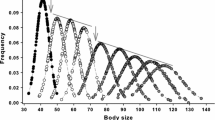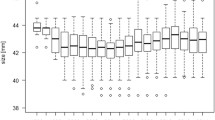Abstract
Studies on the postnatal growth of free-ranging bats can be based on multiple recaptures of marked individuals of known age (longitudinal sampling) or derived from measurements of captured pups with unknown birth dates (cross-sectional sampling). We therefore used individuals of Geoffroy’s bat Myotis emarginatus in a case study to test the hypothesis that these two methods yield similar data on growth rates and growth derivatives. We followed postnatal growth in body mass, forearm length, and total epiphyseal gap in 24 tagged neonates sampled 10 times (via 143 cases of longitudinal sampling) and compared finding with those deriving from cross-sectional sampling carried out on the same occasions among 138 non-tagged neonates of the same colony. A generalized estimating equation relating to the first 3 weeks of postnatal growth indicated that initial values (y-intercepts) for forearm length and body mass did not differ significantly between groups sampled in the two ways (P > 0.05), while rates of growth characterized by these parameters were found to differ significantly (P < 0.05). In relation to the length of total epiphyseal gap obtained for days 12–40, tests for equal intercepts and parallelism confirmed significant differences between the two sampling methods at P < 0.05. Specifically, cross-sectional sampling of the three growth parameters resulted in significant overestimation of ages among the studied bats. However, given the greater logistical challenges with longitudinal sampling, our demonstration of the relative value of the two sampling methods, and of their dependence for accuracy on the amount of variation found in growth variables, allows us to persist in advocating cross-sectional sampling in postnatal studies on bats.



Similar content being viewed by others
References
Allen LC, Richardson CS, McCracken GF, Kunz TH (2010) Birth size and postnatal growth in cave- and bridge-roosting Brazilian free-tailed bats. J Zool 280:8–16. https://doi.org/10.1111/j.1469-7998.2009.00636.x
Baptista TL, Richardson CS, Kunz TH (2000) Postnatal growth and age estimation in free-ranging bats: a comparison of longitudinal and cross-sectional sampling methods. J Mammal 81:709–718. https://doi.org/10.1644/1545-1542(2000)081<0709:PGAAEI>2.3.CO;2
Benda P, Fizolâhi K, Andreas M, Obuch J, Reiter A, Ševčík M, Uhrin M, Vallo P, Ashrafi S (2012) Bats (Mammalia: Chiroptera) of the Eastern Mediterranean and Middle East. Part 10. Bat fauna of Iran. Acta Soc Zool Bohem 76:163–582
Brunet-Rossinni AK, Wilkinson GS (2009) Methods for age estimation and the study of senescence in bats. In: Kunz TH, Parsons S (eds) Ecological and behavioral methods for the study of bats. The Johns Hopkins University Press, Baltimore, MD, pp 315–325
Burles DW, Brigham RM, Ring RA, Reimchen TE (2009) Influence of weather on two insectivorous bats in a temperature Pacific Northwest rainforest. Can J Zool 87:132–138. https://doi.org/10.1139/Z08-146
Chen SF, Huang SS, Lu DJ, Shen TJ (2016) Postnatal growth and age estimation in Scotophilus kuhlii. Zoo Biol 35:35–41. https://doi.org/10.1002/zoo.21251
Cheng HC, Lee LL (2002) Postnatal growth, age estimation, and sexual maturity in the Formosan leaf-nosed bat (Hipposideros terasensis). J Mammal 83:785–793. https://doi.org/10.1644/1545-1542(2002)083<0785:PGAEAS>2.0.CO;2
DeBlase AF (1980) The bats of Iran: systematics, distribution, ecology. Fieldiana Zool ns 4:1–424
DePaz O (1986) Age estimation and postnatal growth of the greater mouse bat Myotis myotis (Borkhausen, 1797) in Guadalajara, Spain. J Mammal 50:243–251. https://doi.org/10.1515/mamm.1986.50.2.243
Eghbali H, Shahabi S, Najafi N, Mehdizadeh R, Yousefi S, Sharifi M (2018) Postnatal growth, wing development and age estimations in the Mediterranean horseshoe bat Rhinolophus euryale (Chiroptera: Rhinolophidae) in Kerend cave, western Iran. Mammalia 82:276–287. https://doi.org/10.1515/mammalia-2017-0006
Eghbali H, Sharifi M (2018) Postnatal growth, age estimation, and wing development in Geoffroy’s bat Myotis emarginatus (Chiroptera: Vespertilionidae). Mammal study 43:153–156. https://doi.org/10.3106/ms2017-0077
Eghbali H, Sharifi M (2019) Birth synchrony and postnatal growth in Rhinolophus ferrumequinum (Chiroptera: Rhinolophidae) in two successive dry (2015) and wet year (2016) in a nursing colony in Kerend cave, western Iran. Ecol Res 34:765–781. https://doi.org/10.1111/1440-1703.12046
Elangovan V, Yuvana Satya Priya E, Raghuram H, Marimuthu G (2003) Postnatal development in the Indian short-nosed fruit bat (Cynopterus sphinx): growth rate and age estimation. Acta Chiropt 5:107–116. https://doi.org/10.3161/001.005.0110
Elangovan V, Yuvana Satya Priya E, Raghuram H, Marimuthu G (2007) Wing morphology and flight development in the short-nosed fruit bat Cynopterus sphinx. J Zool 110:189–196. https://doi.org/10.1016/j.zool.2007.02.001
Engler S, Rose A, Knörnschild M (2017) Isolation call ontogeny in bat pups (Glossophaga soricina). Behaviour 154:267–286. https://doi.org/10.1163/1568539X-00003421
Fernandez AA, Knörnschild M (2017) Isolation calls of the bat Saccopteryx bilineata encode multiple messages. Anim Cogn 4:169–186. https://doi.org/10.12966/abc.04.05.2017
Flaquer C, Puig-Montserrat X, Burgas A, Russo D (2008) Habitat selection by Geoffroy’s bats (Myotis emarginatus) in a rural Mediterranean landscape: implications for conservation. Acta Chiropt 10:61–67. https://doi.org/10.3161/150811008X331090
Horáček I, Hanák V, Gaisler J (2000) Bats of the Pale arctic region: a taxonomic and biogeographic review. In: Woloszyn BW (ed) Proceedings of the VIIIth European Bat Research Symposium. Vol. I. Approaches to Biogeography and Ecology of Bats. Chiropterological Information Centr ISEZ PAN, Kraków, pp11–157
Jin LR, Yang S, Kimball RT, Xie L, Yue X, Luo B, Sun KP, Feng J (2015) Do pups recognize maternal calls in Pomona leafnosed bats, Hipposideros pomona? Anim Behav 100:200–207. https://doi.org/10.1016/j.anbehav.2014.12.006
Jin LR, Lin AQ, Sun KP, Liu Y, Feng J (2011) Postnatal development of morphological features and vocalization in the pomona leaf–nosed bat Hipposideros pomona. Acta Theriol 56:13–22. https://doi.org/10.1007/s13364-010-0011-z
Jin LR, Luo B, Sun KP, Liu Y, Pan Ho J, Feng J (2012a) Postnatal growth and age estimation in Marshall's horseshoe bat, Rhinolophus marshalli. Acta Chiropt 14:105–110. https://doi.org/10.3161/150811012X654312
Jin LR, Wang J, Zhang Z, Sun KP, Kanwal JS, Feng J (2012b) Postnatal development of morphological and vocal features in Asian particolored bat, Vespertilio sinensis. Mamm Biol 77:339–344. https://doi.org/10.1016/j.mambio.2012.05.001
Kleinbaum DG, Kupper LL, Muller KE (1988) Applied regression analysis and other multivariable methods. Duxbury Press, Belmont, Massachusetts
Kunz TH, Adams RA, Hood WR (2009) Methods for assessing size at birth and postnatal growth and development in bats. In: Kunz TH, Parsons S (eds) Ecological and behavioral methods for the study of bats. The Johns Hopkins University Press, Baltimore, MD, pp 273–314
Kunz TH, Anthony ELP (1982) Age estimation and postnatal growth in the bat Myotis lucifugus. J Mammal 63:23–32. https://doi.org/10.2307/1380667
Kunz TH, Hood WR (2000) Parental care and postnatal growth in the Chiroptera. In: Crichton EG, Krutzsch PH (eds) Reproductive biology of bats. Academic Press, London, pp 415–468
Kunz TH, Robson SK (1995) Postnatal growth and development in the Mexican free-tailed bat (Tadarida brasiliensis mexicana): birth size, growth rates, and age estimation. J Mammal 76:769–783. https://doi.org/10.2307/1382746
Lin AQ, Jin LR, Liu Y, Sun KP, Feng J (2010) Postnatal growth and age estimation in Horsfield’s leaf-nosed bat Hipposideros larvatus. Zool Stud 49:789–796
Lin AQ, Jin LR, Shi LM, Sun KP, Berquist SW, Liu Y, Feng J (2011) Postnatal development in Andersen’s leaf–nosed bat Hipposideros pomona: flight, wing shape, and wing bone lengths. J Zool 114:69–77. https://doi.org/10.1016/j.zool.2010.11.006
Liu Y, Jin LR, Metzner W, Feng J (2009) Postnatal growth and age estimation in big-footed Myotis, Myotis macrodactylus. Acta Chiropt 11:105–111. https://doi.org/10.3161/150811009x465721
Lučan RK, Weise M, Hanák V (2013) Contrasting effects of climate change on the timing of reproduction and reproductive success of a temperate insectivorous bat. J Zool 290:151–159. https://doi.org/10.1111/jzo.12021
Mello MAR, Kalko EKV, Silva WR (2009) Ambient temperature is more important than food availability in explaining reproductive timing of the bat Sturnira lilium (Mammalia: Chiroptera) in a montane Atlantic Forest. Can J Zool 87:239–245. https://doi.org/10.1139/Z09-010
Porter TA, Wilkison GS (2001) Birth synchrony in greater spear-nosed bats (Phyllostomus hastatus). J Zool 253:383–390. https://doi.org/10.1017/S0952836901000358
Rajan KE, Marimuthu G (1999) Postnatal growth and age estimation in the Indian false vampire bat (Megaderma lyra). J Zool 248:529–534. https://doi.org/10.1111/j.1469-7998.1999.tb01052.x
Reiter G (2004) Postnatal growth and reproductive biology of Rhinolophus hipposideros (Chiroptera: Rhinolophidae). J Zool 262:231–241. https://doi.org/10.1017/S0952836903004588
Sharifi M (2004a) Postnatal growth and age estimation in the Mehely’s horseshoe bat (Rhinolophus mehelyi). Acta Chiropt 6:155–161. https://doi.org/10.3161/001.006.0112
Sharifi M (2004b) Postnatal growth in Myotis blythii (Chiroptera, Vespertilionidae). Mammalia 68:283–289. https://doi.org/10.1515/mamm.2004.027
Sharifi M, Vaissi S (2013) Postnatal growth in the Long–fingered bat, Miniopterus schreibersii pallidus, in Iran (Chiroptera: Miniopteridae). Zool Middle East 59:1–5. https://doi.org/10.1080/09397140.2013.795053
Sharifi M, Vaissi S, Javanbakht H, Akmali V (2012) Postnatal growth and wing development in Kuhl’s pipistrelle Pipistrellus kuhlii (Chiroptera: Vespertilionidae) in captivity. Zool Stud 51:1235–1247
Short HL (1961) Growth and development of the Mexican free-tailed bat. Southwest Nat 6:156–163. https://doi.org/10.2307/3669328
Stangl FB, Dalquest Jr WW, Grimes JV (1996) Observations on the early life history, growth, and development of the red bat, Lasiurus borealis (Chiroptera Vespertilionidae), in North Texas. In: Genoways HH, Baker RJ (eds) Contributions in Mammalogy: A Memorial Volume Honoring Dr. J. Knox Jones, Jr. Museum of Texas Tech University, Lubbock, Texas, pp 139–148
Swamidoss DP, Parvathiraj P, Sudhakaran MR (2014) Parturition and postnatal growth of Dusky leaf–nosed bat, Hipposideros ater. Asian Australas J Anim Sci 8:1–14. https://doi.org/10.3923/ajas.2014.1.14
Thomas DW, Marshall AG (1984) Reproduction and growth in three species of West African fruit bats. J Zool 202:265–281. https://doi.org/10.1111/j.1469-7998.1984.tb05954.x
Welbergen JA (2010) Growth, bimaturation, and sexual size dimorphism in wild gray–headed flying foxes (Pteropus poliocephalus). J Mammal 91:38–47. https://doi.org/10.1644/09-MAMM-A-157R.1
Yokoyama K, Ohtsu R, Uchida TA (1979) Growth and LDH isozyme patterns in the pectoral and cardiac muscles of the Japanese lesser horseshoe bat, Rhinolophus cornutus cornutus, from the standpoint of adaptation for flight. J Zool 187:85–96. https://doi.org/10.1111/j.1469-7998.1979.tb07715.x
Yousefi S, Najafi N, Mehdizadeh R, Eghbali H, Sharifi M (2018) Postnatal variation in ectoparasite (Spinturnix emarginata) load in neonates of Geoffroy’s bat (Myotis emarginatus): how fast do young bats become infested with ectoparasites? Acta Chiropt 20:187–194. https://doi.org/10.3161/15081109ACC2018.20.1.014
Zahn A, Bauer S, Kriner E, Holzhaider J (2010) Foraging habitats of Myotis emarginatus in Central Europe. Eur J Wildl Res 56:395–400. https://doi.org/10.1007/s10344-009-0331-y
Zeger SL, Laing KY (1986) Longitudinal data analysis for discrete and continuous outcomes. Biometrics 42:121–130. https://doi.org/10.2307/2531248
Author information
Authors and Affiliations
Corresponding author
Ethics declarations
All captures, handling, and field procedures have been conducted on the basis of the protocol approved by the Razi University Animal Care and Ethic Committee (N = 396-2-003).
Additional information
Communicated by: Zuzanna Hałat
Publisher’s note
Springer Nature remains neutral with regard to jurisdictional claims in published maps and institutional affiliations.
Rights and permissions
About this article
Cite this article
Eghbali, H., Sharifi, M. Comparing longitudinal and cross-sectional sampling methods on growth variables and age estimation: lessons from postnatal growth of the Geoffroy’s bat, Myotis emarginatus. Mamm Res 65, 743–753 (2020). https://doi.org/10.1007/s13364-020-00516-9
Received:
Accepted:
Published:
Issue Date:
DOI: https://doi.org/10.1007/s13364-020-00516-9




